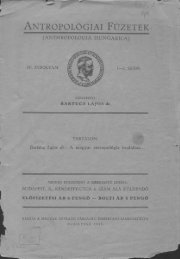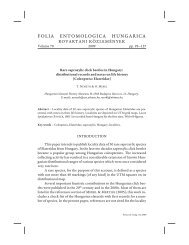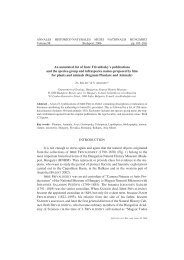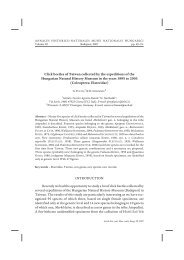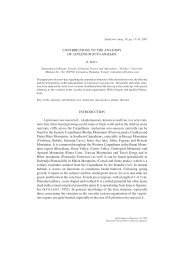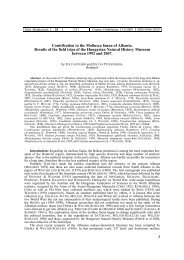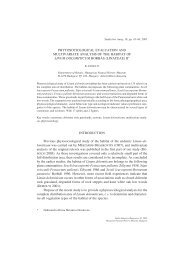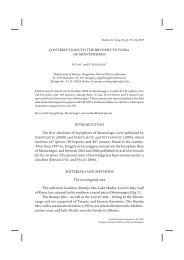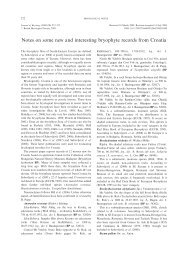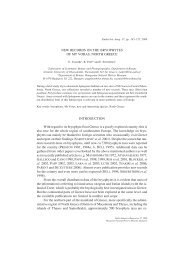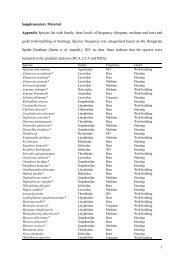THE GENUS SCHISTIDIUM (GRIMMIACEAE, MUSCI) IN HUNGARY ...
THE GENUS SCHISTIDIUM (GRIMMIACEAE, MUSCI) IN HUNGARY ...
THE GENUS SCHISTIDIUM (GRIMMIACEAE, MUSCI) IN HUNGARY ...
Create successful ePaper yourself
Turn your PDF publications into a flip-book with our unique Google optimized e-Paper software.
<strong>THE</strong> <strong>GENUS</strong> <strong>SCHISTIDIUM</strong> <strong>IN</strong> <strong>HUNGARY</strong> 81<br />
Plants green, olive or brownish, rarely black, in loose tufts or decumbent;<br />
hair-point often > 0.2 mm, slightly flattened at base and often<br />
decurrent; exothecial cells not forming an irregular pattern, stomata<br />
usually few (0–6)<br />
(calcareous rocks, often on concrete)<br />
Plants usually black, glossy, in compact cushions; hair-point absent or<br />
short (up to 0.2 mm), coarse and coarsely spinulose with short and<br />
broad, patent to squarrose spinulae, terete, not decurrent; exothecial<br />
cells forming an irregular pattern, stomata absent<br />
(= singarense) (calcareous rocks)<br />
FREQUENCY AND RARITY OF TAXA <strong>IN</strong> <strong>HUNGARY</strong><br />
Fig. 34 shows the proportion of each taxon in a total of 448 sites of all<br />
Schistidium specimens examined. The most frequent taxa are: S. crassipilum<br />
(43.5%), S. brunnescens subsp. brunnescens (16.3%), S. apocarpum (14.1%),<br />
S. lancifolium (7.6%), S. elegantulum (7.6%), and S. helveticum (4.0%). The<br />
other taxa are known from less than 8 sites each: S. robustum (7 sites), S. pruinosum<br />
and S. brunnescens subsp. griseum (6 sites each), S. dupretii (4 sites), S.<br />
flaccidum (3 sites), S. confertum (2 sites), S. confusum, S. papillosum and S.<br />
platyphyllum (1 site each).<br />
From a glance at the geological map of Hungary (RADÓ 1979) it is evident<br />
that, apart from large parts of the country (in the lowlands) covered by<br />
quaternary deposits and thus less inviting for colonisation by saxicoles,<br />
there is (in the mountains and hills) a high diversity in both carboniferous<br />
and siliceous rocks, i.e. potential sites for taxa of Schistidium.<br />
Schistidium has been recorded in 30 out of 43 bryogeographical regions<br />
in Hungary (after Boros 1968). This clearly does not reflect the true<br />
distribution, since weedy species like S. crassipilum, which colonise walls<br />
and concrete, are to be expected in all regions. Among the regions without<br />
Schistidium records (Cserehát Hills, Putnok Hills, Karancs–Medves Mts,<br />
Fertõ Hills, Vend Region, Õrség, Hetés, Göcsej, Zselic, Külsõ-Somogy, Little<br />
Hungarian Plain, Nyírség, Dráva Region), there are even some siliceous<br />
mountains (Karancs–Medves Mts). They were not visited by Hungarian<br />
bryologists as frequently as the other mountain areas, since they were<br />
thought to be less interesting and poorer in species (BOROS 1968).<br />
Studia bot. hung. 39, 2008



